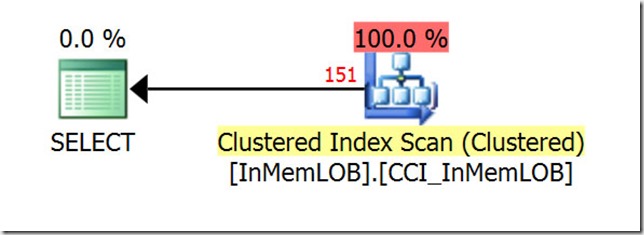In her excellent blog post entitled “Batch Mode Hacks for Rowstore Queries in SQL Server“, Kendra Little b|t pays homage to Itzik Ben-Gan, Niko Neugebauer, and others.
The solutions she details will indeed result in batch mode for rowstore queries. I had already seen the solution proposed by Mr. Ben-Gan, and as is typically the case, a simple example is given to illustrate the concept, and these types of examples are almost always single-threaded.
I have a client that used Itzik Ben-Gan’s solution of creating a filtered nonclustered columnstore index to achieve batch mode on a rowstore (in fact I proposed that the client consider it). They have an OLTP system, and often perform YTD calculations. When they tested, processing time was reduced by 30 to 50 percent, without touching a single line of application code. If that ain’t low hanging fruit, I don’t know what is —
However, during testing, I noticed some intermittent blocking that didn’t make sense to me. But I couldn’t nail it down, and they went live with the “filtered nonclustered columnstore index” solution.
Once they deployed – and there was a lot of concurrency – I could see what had eluded me during my proof of concept: blocking in tempdb.
The repro is super-simple:
- Create a table, and insert some sample data
- Create a stored procedure that does the following:
SELECT from that table into a #temp table
Create a filtered nonclustered columnstore index on the #temp table, using a filter that cannot possibly be true, i.e. IDcolumn < 0 and IDcolumn > 0
SELECT from the #temp table (return results)
From the first connection, issue a BEGIN TRAN execute the stored procedure. Note the spid for this connection. Then open a separate connection, issue a BEGIN TRAN and execute the stored procedure. Note the spid for this connection.
You’ll notice that the first connection has no issues, but when you execute the proc in the second connection, it gets blocked.
When you peel back the layers, you can see that the first connection requests and obtains a schema modification lock on the #temp table (Sch-M).
The second connection requests a schema stability lock on the same object_id, and is blocked (Sch-S).
To be clear, what’s happening here is that separate connections are placing incompatible locks on the same temporary object in tempdb, which is supposed to be impossible (but in fact the object_id is the same). My gut tells me that this is perhaps related to metadata when creating the NCCI, but I couldn’t prove that.
It should be noted that if you remove the filter on the NCCI, there is no blocking, and also if you use a regular filtered nonclustered index (not columnstore), this issue persists. Of course, in the real world, removing the filter is not an option because what we’re interested in speed, and if there’s one thing that columnstore indexes are not fast at, it’s being created.
Hopefully if/when Microsoft fixes this, it will be back ported to earlier versions of SQL Server.
I can reproduce this on SQL 2016 and 2017 (and even 2019, but that’s not really fair, cause it’s not RTM yet…)
If you think that Microsoft should fix this, please upvote my Azure User Voice entry here.
Repro code:
|
1 2 3 4 5 6 7 8 9 10 11 12 13 14 15 16 17 18 19 20 21 22 23 24 25 26 27 28 29 30 31 32 33 34 35 36 37 38 39 40 41 42 43 44 45 46 47 48 49 50 51 52 53 54 55 56 57 58 59 60 61 62 63 64 65 66 67 68 69 70 71 72 73 74 75 76 77 78 79 80 81 82 83 84 85 86 87 88 89 90 91 92 93 94 95 96 97 98 99 100 101 102 103 104 105 106 107 108 109 110 111 112 113 114 115 116 117 118 119 120 121 122 123 124 125 126 127 128 129 130 131 132 133 134 135 136 137 138 139 140 141 142 143 144 |
/* Ned Otter Repro for incompatible lock types when two connections both call the same procedure, and a filtered nonclustered columnstore index is created on a #temp table (for batch mode). If you remove the filter from the NCCI, there is no blocking, but also if you use a regular filtered nonclustered index (not columnstore), this issue persists. Version tested against: SQL 2016/SP2/CU2 SQL 2017 RTM CU5 SQL 2019 CTP2.1 */ /* ################################## Setup: Create table and insert rows ################################## */ DROP TABLE IF EXISTS dbo.SourceTable GO CREATE TABLE dbo.SourceTable ( col1 INT NOT NULL ,col2 INT NOT NULL ,col3 DATETIME ) INSERT dbo.SourceTable ( col1 ,col2 ,col3 ) VALUES ( 12345 ,6789 ,'2018-09-01 00:00:00.000' ) GO /* ################################## Setup: Create procedure ################################## */ CREATE OR ALTER PROCEDURE [dbo].[Proc_GetRows] AS SELECT * INTO #TempTable FROM dbo.SourceTable CREATE NONCLUSTERED COLUMNSTORE INDEX NCCI_#TempTable ON #TempTable(col1) WHERE (col1 < 0 AND col1 > 0) SELECT col1 ,col2 ,col3 FROM #TempTable GO /* ################################## Execute the following statements in two separate connections ################################## */ SELECT @@SPID GO SET XACT_ABORT ON SET NOCOUNT ON BEGIN TRANSACTION EXEC [dbo].[Proc_GetRows] --ROLLBACK /* ################################## Verify locking/blocking ################################## */ DROP TABLE IF EXISTS #locks GO CREATE TABLE #locks ( spid smallint ,dbid smallint ,ObjId int ,IndId smallint ,Type nchar(4) ,Resource nchar(32) ,Mode nvarchar(8) ,Status nvarchar(5) ) INSERT #locks EXEC sp_lock SELECT DISTINCT '1' AS ConnectionNumber ,* FROM #locks WHERE spid = <SPID_from_Connection1> AND Type = 'TAB' AND ObjId < 0 SELECT DISTINCT '2' AS ConnectionNumber ,* FROM #locks WHERE spid = <SPID_from_Connection2> AND Type = 'TAB' AND ObjId < 0 DECLARE @TableID INT = ( SELECT DISTINCT ObjId FROM #locks WHERE spid = <SPID_from_Connection1> AND dbid = 2 AND Type = 'TAB' AND ObjId < 0 ) |


